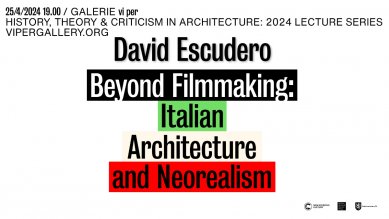
David Escudero: Beyond Filmmaking - lecture at Gallery VI PER
Italian Architecture and Neorealism
Source
Galerie VI PER
Galerie VI PER
Publisher
Tisková zpráva
21.04.2024 17:45
Tisková zpráva
21.04.2024 17:45
Lectures
Czech Republic
Prague
Karlín
After World War II, a wave of Italian films emerged that portrayed the lives and struggles of powerless characters following this conflict and brought to the screen the battles of existential anxiety and uncertainty. This form of filmmaking was associated with a broader artistic phenomenon known as "neorealism," which is now considered a key point in the history of Italian cinema.
Neorealism, however, was not limited to film; it also manifested in literature. It expanded into other areas of artistic creation, including architecture. During these years, terms such as "neorealist architecture" or "architectural neorealism" emerged, referenced in the following decades by numerous architectural historians. The term was therefore adopted ad hoc and popularized post hoc, as there were no manifestos or declarations before 1955 outlining what neorealism in architecture actually was or what it aspired to be. Although this term was commonly used in the context of Italian architectural history, the transfers between neorealism as an aesthetic and ethical domain and architecture as one of the potential media for its embodiment or expression are still not fully understood, leaving significant gray areas.
This lecture examines the connections between architecture, filmmaking, and the built environment in Italy during the so-called dopoguerra (194X–195X) period. Based on the cultural context as a starting point in which neorealism arose, it seeks to determine whether and how it manifested specifically in architecture. The main goal is thus a discussion of the concept of "neorealist architecture" and the assumption that the connection of these two concepts has significance.
David Escudero, Ph.D., is an architect and lecturer in the Department of Architectural Composition at the School of Architecture of the Polytechnic University of Madrid (ETSAM-UPM) and a member of the UPM research group for cultural landscape (GIPC). His research focuses on the intersections between architectural theory, cinematography, and representation. He was a Fulbright Foundation scholar at the Getty Research Institute in Los Angeles (2022) and has served as a visiting scholar at UC Berkeley (2017), ETH Zurich (2017), and the Accademia Nazionale di San Luca in Rome (2018). He is, among other things, the author of articles in The Journal of Architecture (RIBA), Architectural Theory Review, and OASE. His recent book, Neorealist Architecture: Aesthetics of Dwelling in Postwar Italy (Routledge, 2022), was awarded a grant from the American Graham Foundation for Advanced Studies in the Fine Arts and received the Book Prize 2022 from the American Association for Italian Studies.
Neorealism, however, was not limited to film; it also manifested in literature. It expanded into other areas of artistic creation, including architecture. During these years, terms such as "neorealist architecture" or "architectural neorealism" emerged, referenced in the following decades by numerous architectural historians. The term was therefore adopted ad hoc and popularized post hoc, as there were no manifestos or declarations before 1955 outlining what neorealism in architecture actually was or what it aspired to be. Although this term was commonly used in the context of Italian architectural history, the transfers between neorealism as an aesthetic and ethical domain and architecture as one of the potential media for its embodiment or expression are still not fully understood, leaving significant gray areas.
This lecture examines the connections between architecture, filmmaking, and the built environment in Italy during the so-called dopoguerra (194X–195X) period. Based on the cultural context as a starting point in which neorealism arose, it seeks to determine whether and how it manifested specifically in architecture. The main goal is thus a discussion of the concept of "neorealist architecture" and the assumption that the connection of these two concepts has significance.
David Escudero, Ph.D., is an architect and lecturer in the Department of Architectural Composition at the School of Architecture of the Polytechnic University of Madrid (ETSAM-UPM) and a member of the UPM research group for cultural landscape (GIPC). His research focuses on the intersections between architectural theory, cinematography, and representation. He was a Fulbright Foundation scholar at the Getty Research Institute in Los Angeles (2022) and has served as a visiting scholar at UC Berkeley (2017), ETH Zurich (2017), and the Accademia Nazionale di San Luca in Rome (2018). He is, among other things, the author of articles in The Journal of Architecture (RIBA), Architectural Theory Review, and OASE. His recent book, Neorealist Architecture: Aesthetics of Dwelling in Postwar Italy (Routledge, 2022), was awarded a grant from the American Graham Foundation for Advanced Studies in the Fine Arts and received the Book Prize 2022 from the American Association for Italian Studies.
The English translation is powered by AI tool. Switch to Czech to view the original text source.

0 comments
add comment
Related articles
0
02.02.2025 | Fosbury Architecture: +10 - lecture at the VI PER Gallery
0
29.01.2022 | Kim Förster: Uncementing Modernity - online lecture at Gallery VI PER
0
31.10.2021 | Merve Bedir: Automated Landscapes - lecture at Gallery VI PER
0
22.08.2021 | Erika Henriksson: Making-with - lecture at Gallery VI PER
0
24.11.2017 | José Aragüez: The Building - lecture at the gallery VI PER









